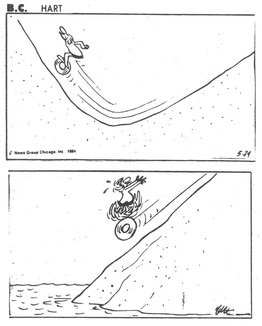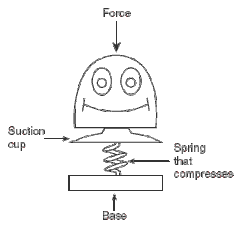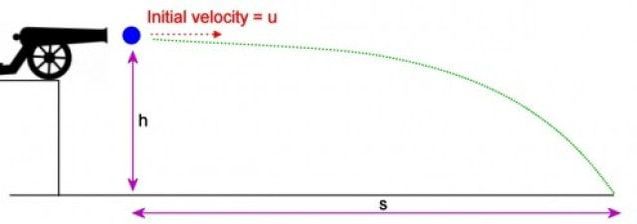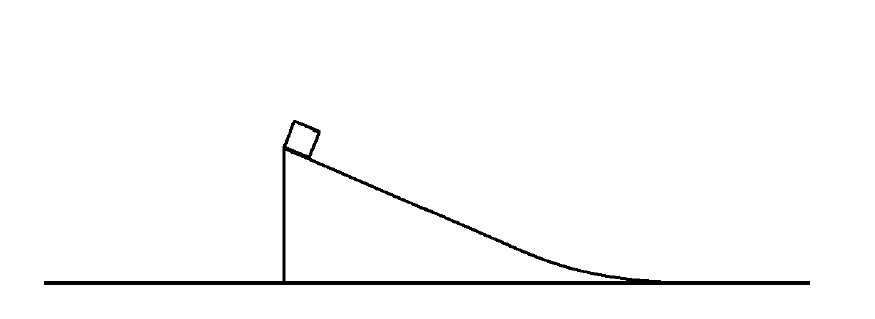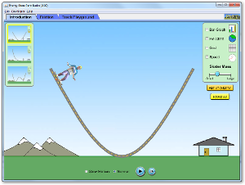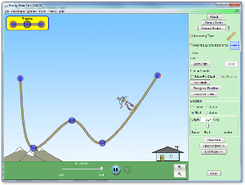|
Home >> AP Physics I >> Energy
|
Momentum >>
|
|
Energy is an abstract concept that underpins all of science. Fundamentally, it is the ability to do work. Energy comes in many forms, however, at AP level the focus is mainly on mechanical energy, which is the sum of the kinetic energy and the potential energy of an object. The key part is that the energy can be transferred between kinetic and potential energies.
Central to this topic is the idea of WORK. As the industrial revolution gathered steam (so to speak) it became necessary to quantify the amount of effort required to do a task such as winching a bucket of coal up from a coal mine and the amount of fuel required to do this task. The concepts that we use today stem from this need. Work is simply the force applied over a distance - i.e. how hard you are pushing something multiplied by how far you have have pushed it. If the force is as at angle, then only the component of the force that actually moves the object is important. Power is a measure of the rate of doing this work. |
In order to do work, you need energy. If the energy transfer is 100% efficient then the energy required is equal to the work. If energy is stored it is referred to as potential energy. There are two forms of potential energy that we cover in this unit; gravitational potential energy, which is the work done in lifting an object against gravity, and elastic potential energy, which is work done to stretch a spring. The energy associated with a moving object is called kinetic energy and is defined as the work done to stop it.
5.1 - Work and Energy
Objectives:
|
Mechanical WORK is the way that we quantify the amount of EFFORT needed to accomplish a task. ENERGY is defined as the ability to do work. If a job requires 40 J of work, we must have a minimum of 40 J of energy to achieve it. It was quickly realised that mechanical effort was the product of how hard you need to push something and how far you pushed it.
\[W = F\Delta x\]
The unit of work is the joule, named after James Prescott Joule who was an english brewer who first realised the link between mechanical work and heat. It is defined as 1 newton of force applied over 1 metre of displacement. Note that work can be positive or negative depending on which object is doing the work and which is having work done to it. This subtlety becomes very important later!
More exactly, the work done is the area under a force-distance graph. If the force is constant, then the above equation is valid. However, if the force is a variable, then we either need calculus or simple geometry to determine the work done. This is particularly the case for the work done by springs.
\[W = F\Delta x\]
The unit of work is the joule, named after James Prescott Joule who was an english brewer who first realised the link between mechanical work and heat. It is defined as 1 newton of force applied over 1 metre of displacement. Note that work can be positive or negative depending on which object is doing the work and which is having work done to it. This subtlety becomes very important later!
More exactly, the work done is the area under a force-distance graph. If the force is constant, then the above equation is valid. However, if the force is a variable, then we either need calculus or simple geometry to determine the work done. This is particularly the case for the work done by springs.
5.2 - Springs
Objectives:
|
Elastic potential energy (EPE or Us) is the energy that is stored in a stretched or squashed spring. It doesn't have to be a spring actually, but any material that can stretch or compress. There is a huge amount of stored energy in a highly tensioned wire or rope. At AP level it is assumed that the spring 'obeys' Hooke's Law. That is that the extension (stretch/squash) is directly proportional to the applied force. The more you stretch a spring the harder it is do stretch, or the more it wants to return back to its rest state. The elastic potential energy is equal to the work done in stretching or squashing the spring. This is numerically equal to the work done by the spring when it is released, assuming 100% efficiency. The derivation for this comes from the area under the F(x) graph.
\[EPE = U_{s}=\frac{1}{2}kx^{2}\]
Now, this is a very useful equation to memorise (which is easy as almost all things energy are in the form 1/2 x constant x variable squared). AP examiners love spring loaded objects that are then launched upwards or sideways and then collide with something else or become a projectile. It is a good way to test a whole range of concepts!
\[EPE = U_{s}=\frac{1}{2}kx^{2}\]
Now, this is a very useful equation to memorise (which is easy as almost all things energy are in the form 1/2 x constant x variable squared). AP examiners love spring loaded objects that are then launched upwards or sideways and then collide with something else or become a projectile. It is a good way to test a whole range of concepts!
5.3 - Gravitational Potential and Kinetic Energy
Objectives:
|
Gravitation Potential Energy (\(GPE\) or \(PE\) or \(U_{g}\)) is the stored energy due to an object's height from the ground. It is the work done in lifting the object or the work done in dropping it. Either way, the equation is straightforward from Work = force x distance. The height is the vertical height.
\[GPE = U_{g}=mg\Delta h\]
Of course, the above equation assumes that the Earth's gravitational field strength is a constant. This is true on a small scale, which is usually what we consider. However, if we moved to a planetary scale, \(g\) is no longer a constant and somewhat dependent on distance. We must start to be careful with signs as well. Strictly speaking, the \(GPE\) at infinity is zero, so if the object loses \(GPE\) as it falls, the value of \(GPE\) is negative. This seems confusing at first. On a local scale, we are really dealing with a DIFFERENCE of \(GPE\) due to a DIFFERENCE in height, so the sign really does not matter. On a planetary scale it can be important.
\[g = \frac{GM}{r^{2}}\]
Assuming that the height = radius, which is the case if we are some distance away:
\[mgh = \frac{GMmr}{r^{2}}\]
\[GPE = -\frac{GMm}{r}\]
The energy associated with a moving object is called the Kinetic Energy (KE or K) and is equal to the work done to stop it. Remember that the work is a measure of the effort required to do a task. The derivation comes from kinematics and Newton's Second Law.
\[KE = K = \frac{1}{2}mv^{2}\]
\[GPE = U_{g}=mg\Delta h\]
Of course, the above equation assumes that the Earth's gravitational field strength is a constant. This is true on a small scale, which is usually what we consider. However, if we moved to a planetary scale, \(g\) is no longer a constant and somewhat dependent on distance. We must start to be careful with signs as well. Strictly speaking, the \(GPE\) at infinity is zero, so if the object loses \(GPE\) as it falls, the value of \(GPE\) is negative. This seems confusing at first. On a local scale, we are really dealing with a DIFFERENCE of \(GPE\) due to a DIFFERENCE in height, so the sign really does not matter. On a planetary scale it can be important.
\[g = \frac{GM}{r^{2}}\]
Assuming that the height = radius, which is the case if we are some distance away:
\[mgh = \frac{GMmr}{r^{2}}\]
\[GPE = -\frac{GMm}{r}\]
The energy associated with a moving object is called the Kinetic Energy (KE or K) and is equal to the work done to stop it. Remember that the work is a measure of the effort required to do a task. The derivation comes from kinematics and Newton's Second Law.
\[KE = K = \frac{1}{2}mv^{2}\]
5.4 - The Conservation of Energy
Objectives:
|
The principle of conservation of energy is simple: energy cannot be created or destroyed, but only transferred from one form to another. Generally its application as a tool for problem-solving at AP level is pretty straightforward. We either assume that energy transfers are 100% efficient or have to calculate the energy lost.
e.g. speed of an apple falling:
\[GPE\rightarrow KE\]
\[mg\Delta h=\frac{1}{2}mv^{2}\]
\[v=\sqrt{2g\Delta h}\]
e.g. speed of an apple falling:
\[GPE\rightarrow KE\]
\[mg\Delta h=\frac{1}{2}mv^{2}\]
\[v=\sqrt{2g\Delta h}\]
e.g height gained by a spring loaded pop-up toy
|
When the spring is compressed, elastic potential energy is stored within. Once the suction cup releases, this energy is transferred into the kinetic energy of motion, which is in turn converted into gravitational potential energy. Or in shorthand:
\[EPE\rightarrow KE\rightarrow GPE\] \[\frac{1}{2}kx^{2}=\frac{1}{2}mv^{2}=mg\Delta h\] Of course, this assumes that there are no energy losses to heat due to air resistance etc. |
e.g. the launching of a cannonball off a cliff.
|
When the cannonball leaves the cliff top it has BOTH GPE and KE, which get converted to just KE at the bottom. Note that we must ignore energy losses due to air resistance and friction. We can derive the same answer using kinematics and combining the final vertical and horizontal components of the velocities using Pythagoras, but this is far easier!
|
\[GPE + KE_{initial}\rightarrow KE_{final}\]
\[mg\Delta h+\frac{1}{2}mv_{o}^{2}=\frac{1}{2}mv^{2}\]
\[v^{2}=v_{o}^{2}+2g\Delta h\]
TOP TIP #52: Any problem that involves an object moving up or falling can usually be solved by applying the conservation of energy.
However, once we get beyond this practicality and look deeper, we have some difficult questions to ask/answer. Where did the energy originally come from? What will happen once it has all been transferred to heat? These are mind-blowing concepts!
\[mg\Delta h+\frac{1}{2}mv_{o}^{2}=\frac{1}{2}mv^{2}\]
\[v^{2}=v_{o}^{2}+2g\Delta h\]
TOP TIP #52: Any problem that involves an object moving up or falling can usually be solved by applying the conservation of energy.
However, once we get beyond this practicality and look deeper, we have some difficult questions to ask/answer. Where did the energy originally come from? What will happen once it has all been transferred to heat? These are mind-blowing concepts!
Example of an AP-1 Question on the Conservation of Energy.
|
A block is positioned at the top of a frictionless wedge-shaped ramp. Two experiments are performed.
|
There is a lot of physics in this question. The answer is Experiment A, but why?!
5.5 - The Work-Energy Theorem
The so-called work-energy theorem stems from the definition of KE. The kinetic energy of an object is defined as the work required to stop it, or conversely, to accelerate it. We usually just consider the limiting case of moving to stationary or vice versa. However, it can be just that the object changes speed - so the work done is equal to the difference between the initial and final kinetic energies. This is useful as it can provide an easier method of solving an accelerated object problem than using kinematics and dynamics. Note: we must still arrive at the same answer though!
\[W = \Delta KE\]
So, if an object is at the top of a rough slope, it will slide down losing its potential energy, but not all of it will be converted into kinetic energy, so will be transferred to heat via friction. As the kinetic energy at the bottom will be less than if there was no friction, then the object will be slower. The work done by friction can be calculated using work = force x distance.
\[GPE_{top}=KE_{bottom}+W_{friction}\]
If a moving object is pushed up a hill by an external force, then its final potential energy is the sum of its initial kinetic energy and the work done on raising it. The 'extra' energy has been added by the external force. If springs are included, then the elastic potential energy must be accounted for.
This is the final part of the 'accounting' of the energy before and after an event. Overall, the total energy before must equal to that after. If a force is applied to an object, then the work done by that force increases the net energy. If the object does work on its surroundings then its net energy is reduced. It is always worth pausing and considering whether work has been added or removed from the object. This is known as the First Law of Thermodynamics and we will look at this concept in more detail in Unit 14 - Thermal Physics (AP-2).
\[W = \Delta KE\]
So, if an object is at the top of a rough slope, it will slide down losing its potential energy, but not all of it will be converted into kinetic energy, so will be transferred to heat via friction. As the kinetic energy at the bottom will be less than if there was no friction, then the object will be slower. The work done by friction can be calculated using work = force x distance.
\[GPE_{top}=KE_{bottom}+W_{friction}\]
If a moving object is pushed up a hill by an external force, then its final potential energy is the sum of its initial kinetic energy and the work done on raising it. The 'extra' energy has been added by the external force. If springs are included, then the elastic potential energy must be accounted for.
This is the final part of the 'accounting' of the energy before and after an event. Overall, the total energy before must equal to that after. If a force is applied to an object, then the work done by that force increases the net energy. If the object does work on its surroundings then its net energy is reduced. It is always worth pausing and considering whether work has been added or removed from the object. This is known as the First Law of Thermodynamics and we will look at this concept in more detail in Unit 14 - Thermal Physics (AP-2).
5.6 - Power
Objectives:
|
Power is the rate of doing work. It adds the time dependency to the situation. If two machines are doing the same task, the one that does it quicker is the more powerful machine. This true for engines and boats as well as computers or phones!
\[P=\frac{W}{t}\]
\[P=\frac{W}{t}\]
5.7 - Systems
One of the BIG differences with the new AP Physics 1 course is that it likes to ask about SYSTEMS. For example, in the old days we would talk about the work done by raising an apple from the ground and it gains GPE. We rarely consider the Earth as it essentially does not move. But if we were to consider both the apple and the Earth simultaneously, does the system gain, lose or have the same energy as before? One of the ways to think about this is to consider if work has had to be done to or from outside the system. I personally find this rather tricky!
